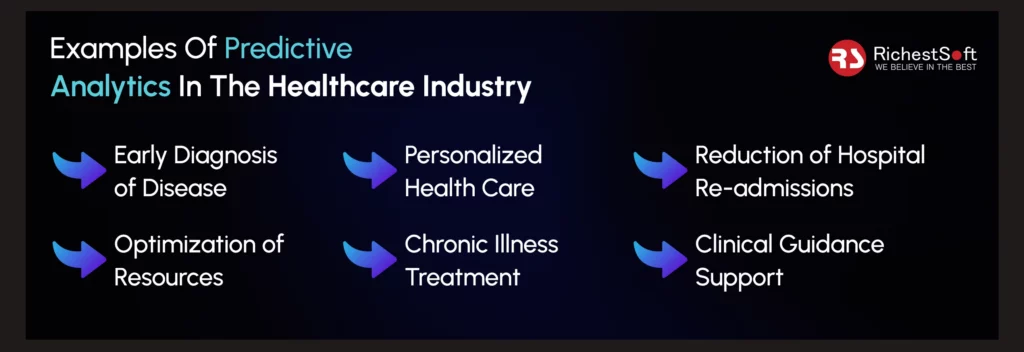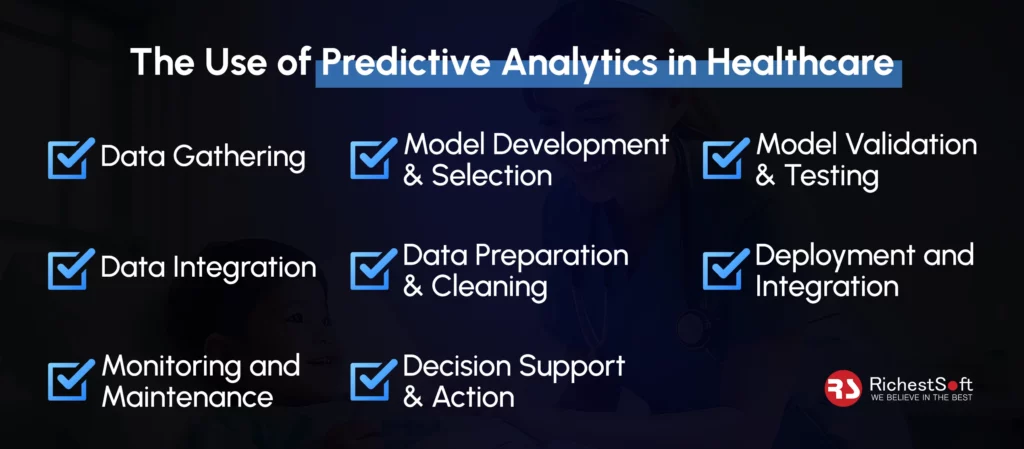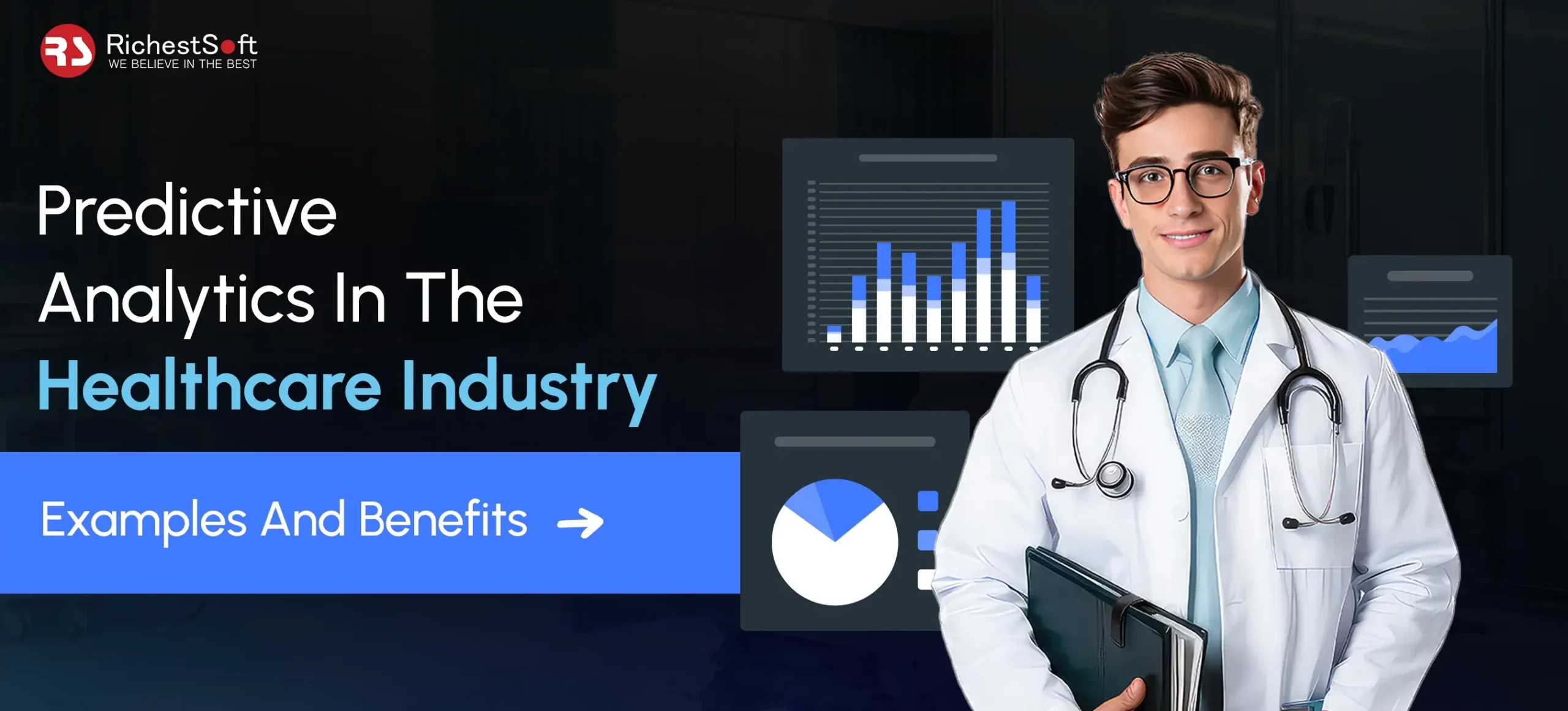October 16, 2024
Like any other sector, the healthcare industry is also seeking growth in digital transformation, whether for handling resources, managing operations, or examining patients.
However, with a crowd of patients with different health concerns, it becomes challenging for doctors and healthcare institutions to keep data for every patient and cure them accordingly.
The predictive analytics market has grown worldwide, with over USD 14.51 billion in 2023, and is expected to reach USD 17.99 billion in 2024. With the growing demand, it will likely reach around USD 154.61 billion by 2034, expanding at a CAGR of 24%.
This is where predictive analytics become the backbone of the healthcare industry. Data-driven analysis of patients’ health issues gives doctors comprehensive access to all patients’ current and historical healthcare data.
At RichestSoft, we know how crucial predictive analytics is in transforming the healthcare sector.
Our cutting-edge predictive analytics in healthcare examples integrated into our solutions make us the best healthcare app development company.
We unlock the potential of data, empowering medical professionals to make wise decisions and providing personalized examples of predictive analytics in healthcare.

What is Predictive Data Analytics in Healthcare?
Recognizing the examples of predictive analytics in healthcare to know the potential to improve patient care, streamline operations, and boost industry efficiencies is essential to understanding its role in the healthcare sector.
Predictive analytics can estimate health outcomes and trends using vast data, including genetic information, lifestyle factors, medical history, and real-time health measurements.
This data-driven approach allows healthcare professionals to manage chronic disorders better, identify diseases early, and create individualized treatment regimens, leading to improved patient outcomes.
By anticipating patient admissions and allocating resources optimally, hospitals can better manage patient influx, reduce wait times, and improve operational efficiency.
Key Components of Predictive Data Analytics in Healthcare
To convert raw data into useful insights, predictive data analytics in healthcare entails several elements that must cooperate.
To properly apply examples of predictive analytics in healthcare to enhance patient care and operational efficiency, healthcare professionals must thoroughly understand the main elements, summarized as follows:
1) Data Collection and Integration
Reliable data collection and integration form the basis of predictive analytics. Numerous sources provide healthcare data, such as wearable technology, medical imaging, genetic data, electronic health records (EHRs), and patient surveys. Integrating these many data sources ensures a thorough understanding of patient health using predictive analytics examples in healthcare.
2) Processing and Cleaning of Data
Raw data often contains inconsistencies, mistakes, and missing numbers. Sorting and arranging the data into a format that may be used is known as data processing and cleaning. This phase is essential for accurate and reliable prediction models.
3) Statistical Inference and Artificial Intelligence
Predictive analytics uses statistical models and machine learning techniques to find patterns and links in the data. Depending on the complexity of the data, these models might be as basic as linear regression or as sophisticated as neural networks.
4) Risk Assessment and Forecasting
Risk stratification is one of the healthcare industry’s main predictive analytics uses. By evaluating patient data, predictive models can identify people highly susceptible to specific illnesses or unfavorable outcomes. This makes early intervention and focused treatment programs possible.
5) Assessment of Results and Ongoing Support
Predictive models must be regularly reviewed and updated to be accurate and successful. This entails monitoring results, comparing forecasts to actual outcomes, and improving models using predictive analytics examples in healthcare.
At RichestSoft, we offer tailored on demand app development solutions that harness the power of predictive analytics. Let’s connect and explore how our apps can optimize your healthcare operations.
Examples Of Predictive Analytics In The Healthcare Industry
Predictive analytics is revolutionizing the healthcare sector by using data to optimize resources, improve patient outcomes, and boost operational efficiency.
The following are some notable examples illustrating the influence of predictive analytics in the healthcare industry:

🡆 Early Diagnosis of Disease
Predictive analytics can detect early indicators of diseases like cancer, diabetes, and cardiovascular disorders by examining patient data patterns. Early identification makes quick treatment possible, enhancing patient outcomes and lowering medical expenses.
🡆 Personalized Health Care
Predictive analytics is useful in creating individualized treatment strategies by evaluating genetic, environmental, and lifestyle data. This method ensures patients receive the best possible care using their qualities.
🡆 Reduction of Hospital Re-admissions
Predictive algorithms can identify patients at an increased risk of readmission after discharge. Healthcare professionals can enhance patient outcomes and lower readmission rates by implementing focused interventions, such as home visits and follow-up care.
🡆 Optimization of Resources
Predictive analytics can optimize the allocation of resources, such as staffing, inventory control, and bed management, by forecasting patient admissions. This aids in improving patient care and operational efficiency for healthcare facilities.
🡆 Chronic Illness Treatment
Predictive analytics can track the course of a chronic illness and identify potential flare-ups in individuals. Patients with chronic diseases can live better lives with proactive management and prompt therapies made possible by this.
🡆 Clinical Guidance Support
The insights derived from data analysis and predictive analytics help healthcare providers make well-informed clinical judgments. This assistance may result in better diagnosis and treatment strategies.
Top 6 Benefits Of Predictive Analytics In Healthcare
In the healthcare sector, predictive analytics is revolutionary because it provides many advantages that improve patient care, operational effectiveness, and other healthcare services.
Our healthcare software development uses expert predictive analytics to help you achieve better patient outcomes.
Our solutions can make a difference and have the following main benefits for the healthcare industry:
1. Better Results
Better patient outcomes are achieved when diseases are detected early, and therapies are implemented promptly through predictive analytics. Healthcare practitioners can enhance the quality of care and patient prognosis by detecting health issues early on and developing customized treatment strategies and preventive actions.
2. Reduced Expenses
Predictive analytics has the potential to drastically lower healthcare expenses. Healthcare providers can save operating costs by minimizing emergencies, limiting hospital readmissions, and allocating resources optimally. Making data-driven decisions with predictive analytics facilitates process optimization and reduces wasteful expenditures.
3. Improved Efficiency in Operations
Forecasting patient admissions, staffing, and resource requirements helps hospitals run more efficiently. Reducing wait times and raising patient satisfaction ensures that healthcare facilities are equipped to manage patient volumes. Effective resource management results in more operational efficiency and improved utilization of the healthcare infrastructure.
4. Personalized Care
One of predictive analytics’ biggest advantages is personalized treatment. Healthcare providers can create customized treatment regimens by examining individual patient data, which includes lifestyle, environmental, and genetic factors. This individualized approach guarantees better health outcomes, ensuring patients receive the best treatments based on their needs.
5. Proactive Chronic Disease Management
Predictive analytics makes proactive illness management possible for people with chronic disorders. By closely observing patient data, healthcare professionals can forecast illness flare-ups and modify treatment regimens accordingly. This proactive approach lowers long-term healthcare expenditures, enhances patient quality of life, and decreases problems.
6. Fewer Hospital Readmissions
Predictive models enable healthcare practitioners to tailor their interventions by identifying patients at a high readmission risk. Hospitals can optimize patient recovery, lower readmission rates, and raise overall patient satisfaction by providing home visits, follow-up care, and other support services.
The Use of Predictive Analytics in Healthcare
Predictive analytics can produce insights that improve patient care and operational effectiveness in the healthcare industry using a systematic data gathering, processing, modeling, and implementation approach.
An outline of the uses of predictive analytics in healthcare is provided below:

🗹 Data Gathering
Healthcare predictive analytics begins with gathering massive data from multiple sources, including wearable technology, medical imaging, electronic health records (EHRs), and patient questionnaires. This data includes clinical history, blood results, lifestyle factors, and patient demographics. Obtaining precise and thorough data is essential since it is the basis for all other analyses.
🗹 Model Development and Selection
After the data has been prepared and combined, the following stage is to choose and create predictive models. Suitable statistical or machine learning algorithms must be selected to evaluate the data and generate predictions. Models are trained using past data to identify patterns and associations that might be utilized to predict future events.
🗹 Model Validation and Testing
A predictive model must be tested and verified to ensure accuracy and reliability. The model’s performance must be assessed using distinct validation datasets and measures like F1 score, precision, and recall. This stage aids in optimizing the model and verifying that it offers practical insights.
🗹 Data Preparation and Cleaning
After being gathered, the data needs to be cleaned and ready for analysis. This includes standardizing data formats, eliminating duplicates, and addressing missing values. Data preparation also includes converting raw data into a format appropriate for analysis to ensure consistency and accuracy.
🗹 Data Integration
Diverse sources frequently provide healthcare data. These disparate datasets must be combined and aligned through data integration to produce a cohesive view. This stage makes predictions more accurate and contributes a more comprehensive picture of the patient’s health.
🗹 Deployment and Integration
The predictive model is integrated into healthcare systems or implemented in clinical settings following a successful validation process. Healthcare workers can now access real-time forecasts and insights. Ensuring the model integrates well with current procedures and systems is essential for effective deployment.
🗹 Monitoring and Maintenance
After deployment, the model’s performance requires ongoing monitoring and maintenance. This entails monitoring its accuracy, adding new data, and making necessary adjustments to make it more patient—or healthcare-centered. Frequent upkeep ensures that the model will always be applicable and functional.
🗹 Decision Support and Action
Predictive analytics’ main objective is to assist decision-making. RichestSoft’s predictive analytics in healthcare examples assist healthcare professionals in making well-informed decisions about patient care, including identifying high-risk patients, refining treatment strategies, and enhancing results.
This stage converts forecasted knowledge into workable plans and solutions.
Conclusion
With the continuously changing digital world, predictive analytics has become one of the major success factors in the healthcare industry. Companies like RichestSoft have become the premier choice for healthcare software development delivering quality with predictive analytics in healthcare examples.
Our expert software developers integrate comprehensive data from diverse sources and utilize advanced statistical models and artificial intelligence to let healthcare providers foresee patient needs and provide personalized treatment plans.
This data-driven approach improves patient outcomes, reduces healthcare costs, and streamlines hospital operations and resource management.
Our expertise in developing and integrating sophisticated predictive models ensures your business’ success. Connect with us to explore how our innovative solutions can enhance your healthcare practices.

 +1 315 210 4488
+1 315 210 4488 +91 99888 06489
+91 99888 06489






